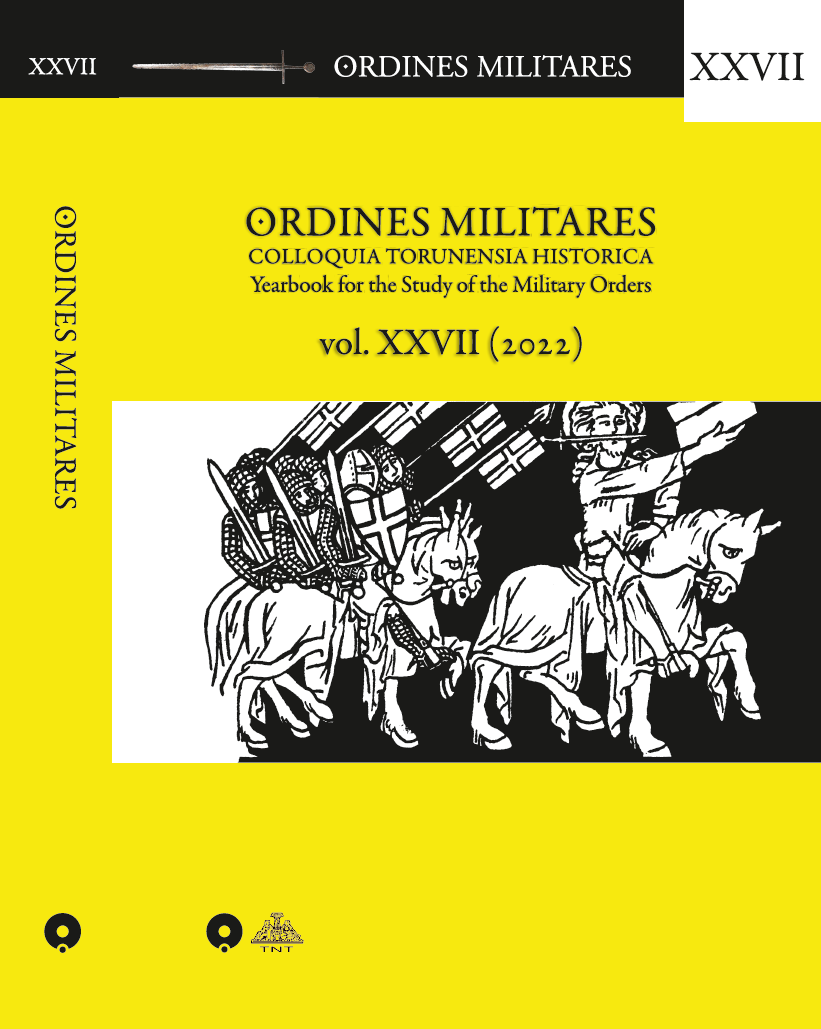Saint Bridget of Sweden and the Teutonic Knights. Her Revelations in the context of the Gothic crucifix from the Holy Trinity Cathedral in Kulmsee (Chełmża) and the legacy of other mystics
DOI:
https://doi.org/10.12775/OM.2022.009Słowa kluczowe
art history, the Middle Ages, military orders, Teutonic Knights, Saint Bridget of Sweden, Revelations, crucifix, KulmseeAbstrakt
The article presents an analysis of the early fifteenth-century wood-carved crucifix from the Holy Trinity cathedral in Kulmsee (Chełmża) in the context of the fourteenth-century Brigidian Revelations. The crucifix was created in a unique in the Teutonic Order State four-nails type. It differs from other, more distant, and older, crucifixes of the four-nails type. In my opinion, the crucifix, because of its inspirations which come from the Revelations of Saint Bridget of Sweden, is another type of a mystical work of art; however, it does not belong to the fourteenth-century widespread type of mystical, extremely suffering crucifixes. My intention is to show that the reception of ideas and motifs in the Gothic times could also be apolitical, although it might be considered a paradox since we have in mind some critical remarks of Saint Bridget towards the Teutonic Order. Furthermore, I emphasise that in the fourteenth century, which was a period distinguished by flourishing mysticism, were present certain similarities in writings of various mystics, which can be compared to a style of the particular time – in German, “Zeitstil”. The discussed crucifix is another evidence that in Christian art the sculptors and their instructors had tremendous artistic licence, and the sacred image along with its visual language was of significant importance for the piety of that period.
Bibliografia
Primary sources:
Biblia sacra: iuxta vulgatam versionem. Adiuvantibus Bonifatio Fischer, Iohanne Gribomont, H. F. D. Sparks and W. Thiele. Recensuit et brevi apparatu instruxit Robertus Weber. Stuttgart: Deutsche Bibelgesellschaft, 1983, 3rd edition.
Fizjologi i Aviarium: średniowieczne traktaty o symbolice zwierząt. Translated and edited by Stanisław Kobielus. Kraków: Tyniec Wydawnictwo Benedyktynów, 2005.
Heliga Birgitta. Revelaciones. Book I, with Magister Mathias’ Prologue. Edited by Carl-Gustaf Undhagen. Uppsala: Almqvist&Wiksells, 1978.
Heliga Birgitta. Revelaciones. Book VI. Edited by Birger Bergh. Stockholm: Berlings, Arlöv, Sweden, 1991.
Heliga Birgitta. Revelaciones. Lib. VII. Edited by Birger Bergh. Uppsala: Almqvist&Wiksells Boktryckeri AB, 1967.
Sancta Birgitta. Revelaciones. Book II. Edited by Carl-Gustaf Undhagen, and Birger Bergh. Stockholm–Västervik: AB C O Ekblad & Co, 2001.
Sancta Birgitta. Revelaciones. Lib. IV. Edited by Hans Aili. Stockholm: Almqvist & Wiksell, 1992.
Seuse, Heinrich. Des Mystikers Heinrich Seuse O. Pr. deutsche Schriften: Vollst. Ausg. auf Grund d. Handschriften. Edited and translated by Nikolaus Heller. Regensburg: Verlagsanstalt vorm. G. J. Manz, 1926.
Seuse, Heinrich. Stundenbuch der Weisheit = Das „Horologium sapientiae“. Translated by Sandra Fenten. Würzburg: Königshausen & Neumann, 2007.
Teologia niemiecka / Frankfurtczyk. Translated by Piotr Augustyniak. Warszawa: Fundacja Augusta hrabiego Cieszkowskiego, 2013.
The Oxford annotated Bible with the Apocrypha: revised standard version: with an introductory article: The number, order, and names of the Books of the Bible. Edited by Herbert G. May and Bruce M. Metzger. New York–Oxford: Oxford University Press, 1965.
The Revelations of St. Birgitta of Sweden. Vol. 1, Liber caelestis, books I–III. Translated by Denis Searby. Edited by Bridget Morris. Oxford–New York: Oxford University Press, 2006.
The Revelations of St. Birgitta of Sweden. Vol. 2, Liber caelestis, books IV–V. Translated by Denis Searby. Edited by Bridget Morris. Oxford–New York: Oxford University Press, 2008.
The Revelations of St. Birgitta of Sweden, Vol. 3, Liber Caelestis, Books VI–VII. Translated by Denis Searby. Edited by Bridget Morris. Oxford–New York: Oxford University Press, 2012.
Secondary sources:
Arnold, Dana. Art History: A Very Short Introduction. Oxford: Oxford University Press, 2020.
Ashley, Benedict M. “Laicization of Spirituality: Christian Perspectives.” In Encyclopedia of Monasticism. Vol. 1, A–L, edited by William M. Johnston, 740–742. Chicago–London: Fitzroy Dearborn Publishers, 2000.
Cirlot, Juan Eduardo. Słownik symboli. Translated by Ireneusz Kania. Kraków: Wydawnictwo Znak, 2012, 3rd edition.
Clasen, Karl Heinz. Die mittelalterliche Bildhauerkunst im Deutschordensland Preussen. Die Bildwerke bis zur Mitte des 15. Jahrhunderts. Vol. 1. Berlin: Deutscher Verein für Kunstwissenschaft, 1939.
Copleston, Frederick. Historia filozofii. Vol. 3. Od Ockhama do Suáreza. Translated by Sylwester Zalewski and Henryk Bednarek. Warszawa: Pax, 2004, 2nd edition.
Godlewicz-Adamiec, Joanna. Plastyczne i językowe środki wyrazu w dziełach mistyków niemieckich epoki średniowiecza. Warszawa: Instytut Germanistyki Uniwersytetu Warszawskiego / author’s own publication, 2005.
Górnicki, Maciej. Antropologia czternastowiecznych mistyków angielskich. Lublin: Wydawnictwo KUL, 2018.
Herrmann, Christofer. Mittelalterliche Architektur im Preussenland: Untersuchungen zur Frage der Kunstlandschaft und -geographie. Petersberg: Michael Imhof Verlag / Olsztyn: Artes, 2007.
Kobielus, Stanisław. Bestiarium chrześcijańskie: zwierzęta w symbolice i interpretacji: starożytność i średniowiecze. Warszawa: Pax, 2002.
Kopaliński, Władysław. Słownik symboli. Warszawa: Oficyna Wydawnicza Rytm, 2017.
Kvapilová, Ludmila. Vesperbilder in Bayern: von 1380 bis 1430 zwischen Import und einheimischer Produktion. Petersberg: Michael Imhof Verlag, 2017.
Mâle, Émile. L'art religieux apres le Concile de Trente: étude sur l'iconographie de la fin du XVIe siecle, du XVIIe, du XVIIIe siecle: Italie, France, Espagne, Flandres. Paris: Librairie Armand Colin, 1951.
Nees, Lawrence. Early medieval art. Oxford–New York: Oxford University Press, 2002.
Oldemeyer, Gertrude. Die Darstellung des gekreuzigten Christus in der Kunst des ”Weichen Stils“. Freiburg im Breisgau: Univ. Diss., 1965.
Spież, Jan Andrzej. “Podstawowe cechy duchowości dominikańskiej.” In Duchowość zakonna: szkice, edited by Jerzy Kłoczowski, 51–65. Kraków: Znak, 1994.
Waszak, Przemysław. “Gotycki krucyfiks z katedry Trójcy Świętej w Chełmży.” Rocznik Grudziądzki 29 (2021): 55–78.
Waszak, Przemysław. “Gotycki krucyfiks ze Żmijewa i jego powiązania artystyczne oraz ideowe.” Rocznik Grudziądzki 28 (2020): 55–71.
Wehrhahn-Stauch, Liselotte. “Biene, Bienenkorb.” In Lexikon der christlichen Ikonographie. Vol. 1. Allgemeine Ikonographie. A bis Ezechiel, edited by Engelbert Kirschbaum, 299–301. Rom–Freiburg–Basel–Wien: Herder, 1994.
Wood, Christopher S. A History of Art History. Princeton–Oxford: Princeton University Press, 2021.
Opublikowane
Jak cytować
Numer
Dział
Licencja
Prawa autorskie (c) 2023 Przemysław Waszak

Utwór dostępny jest na licencji Creative Commons Uznanie autorstwa – Bez utworów zależnych 4.0 Międzynarodowe.
CC BY ND 4.0. Posiadaczem prawa autorskiego (Licencjodawcą) jest Autor, który na mocy umowy licencyjnej (LINK) udziela nieodpłatnie prawa do eksploatacji dzieła na polach wskazanych w umowie.
Statystyki
Liczba wyświetleń i pobrań: 538
Liczba cytowań: 0



